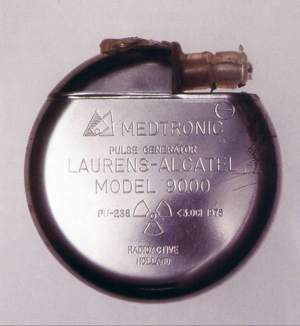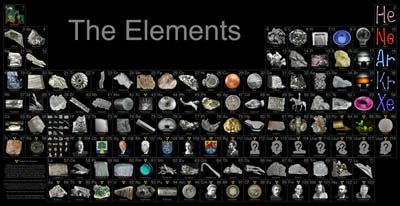Empty nuclear battery.
This empty canister is clearly marked with stamped lettering indicating it is a plutonium battery containing "less than 3 curies" (which is a lot) of plutonium-238 in 1973. Good thing it's completely empty or else it would be a quite dangerous and highly regulated object (yes, I checked it with a Geiger counter and it's dead as a doornail).
I'm told that plutonium batteries were used in pacemakers and that a number still remain implanted in living people. I don't know if this is one that was intended for that application: It looks a bit big to me, but I suppose there's plenty of room in there. I wonder what the protocol is when someone dies with one of these. Does the NRC come to reclaim it? What if there are religious objections to an autopsy? What if they just forget and years later the battery is dug up at a construction site? So many questions, so little time to look up the answers.
But fortunately reader Andrew Hansen has come to my rescue with the following email a few months after I added this item:G'day Theodore,
I was just browsing your periodic table site researching plutonium batteries for a project and I came across your reference to plutonium powered pacemakers.
Having just left 15 years in the pacemaker industry to pursue a career as a high school physics teacher I can not only tell you that such things did exist I can provide you with a photo of the beast:

The R9000 was circa about 1970 and was, by today's standards, quite simplistic. It sold mostly behind the old iron curtain and some devices are still going but not many. The idea did not take off in the west for two reasons. The first is the hysteria of implanting plutonium. The second is that most pacemaker companies (and there are only 4 that sell world wide-the list goes up to about 6-8 if you include companies that sell in Europe only) and each company will bring out a new model every 1 to 2 years. Today's devices use either lithium iodine or lithium monofluride batteries and last around 8 years. That means that by the time your battery runs out your device has been superseded at least 3 times.
These days the improvements are minor but as you go back the jumps get more significant. Getting an R9000 would mean spending the rest of your life driving a manual car with no air conditioning, no radio and probably no seat belts either. In the pacing industry you want devices to have a finite lifetime.
Cheers,
Andrew Hansen. Naturally I responded by asking if he knew where I might get a hold of one, and whether he knew if people were actually buried with them. I had my shovel ready just in case. Ha ha just kidding. I like his answer:Now for the info that will that will really rock you. They probably would bury someone with a plutonium pacemaker - reason: who would know?
Let me explain. The only people who really know anything about the device would be the company rep that sold it to the hospital and maybe the physician who implanted it. In Oz (where I hail from) company reps attend most implants and the physicians often do not know a lot about the
internals of the devices. The patient and family often know nothing as they are generally senior citizens by the time they get a pacemaker. I am generalizing of course.
When patients reach the end of their lives the first thing they do is stop coming to their routine follow up checks (usually done every 12 months) and so the only people who know anything about what is in them lose contact.
When the patient finally dies the mortician may look for and explant a pacemaker - they're easy to see as they are implanted between the skin and the muscle in the upper chest just under one of the collar bones - but if the family plan to bury rather than cremate then the mortician may not bother.
Pacemakers must be explanted for cremation as a lithium iodine cell has a lot of really powerful chemistry in it - usually 1.2Ahr with a rundown curve that stays flat at the nominal voltage for 90% of its working life before a rapid rundown. If you incinerate one of those little beauties they will actually damage the furnace (which happened here in Oz some years back).
So you can see that it all hinges on the mortician and companies and other health care workers generally have very little contact with them so they have no idea what to do or what to look for.
As for getting hold of one - little chance I would think. They really did not take off in the west so there won't be many in people's desk drawers as "my first pacemaker".
Cheers,
A.
Well, all I can say is, if you're a mortician and you've got any "explanted" pacemakers in your desk drawer, please check them for radiation symbols. I can be reasonable if you have something I want. And if you think you might have a plutonium pacemaker in you, and you're not dead yet, please do consider me in your will. Oh God, did I really say that? (Actually, this is a joke, please don't send me an intact plutonium battery. Even I have my limits, and the NRC takes the location of plutonium batteries quite seriously.)
I almost lost this battery on eBay: I was outbid at $160. But through amazing luck and kindness, the winner, George Kamin, allowed me to take over his winning bid and buy the item myself. (Actually he even offered to pay for it and donate it to my collection, but just the ability to get it for only $2 more than my bid was more than kind enough.)
I chose this sample to represent its element in my Photographic Periodic Table Poster. The sample photograph includes text exactly as it appears in the poster, which you are encouraged to buy a copy of.

Source: eBay seller allthedodaday
Contributor: Theodore Gray
Acquired: 10 November, 2004
Text Updated: 11 August, 2007
Price: $162
Size: 1.5"
Purity: 0%
Sample Group: Medical
|

